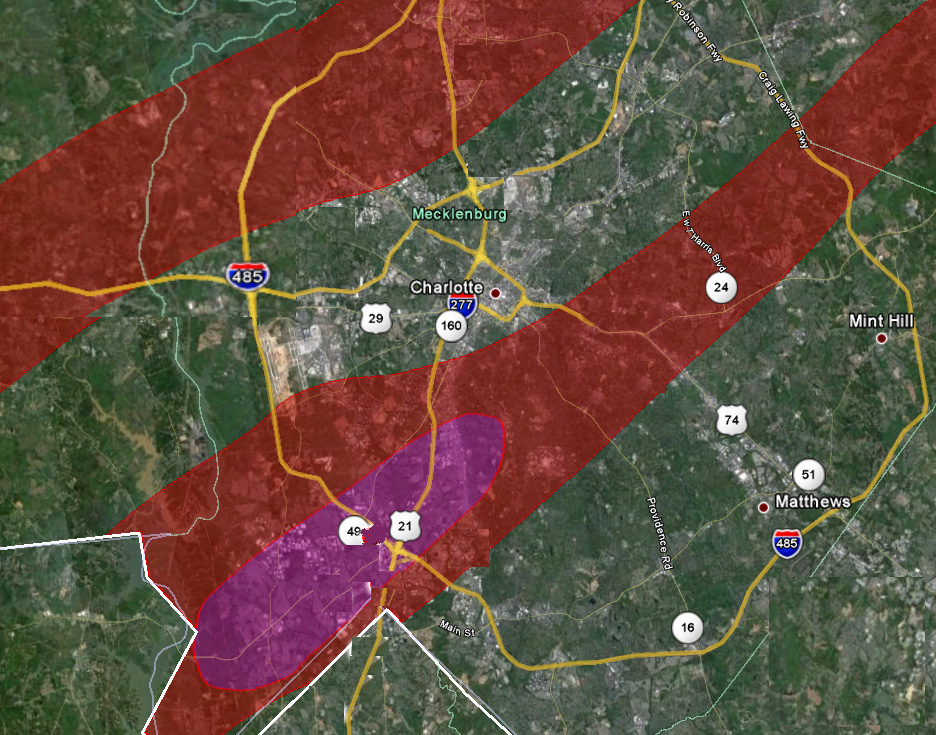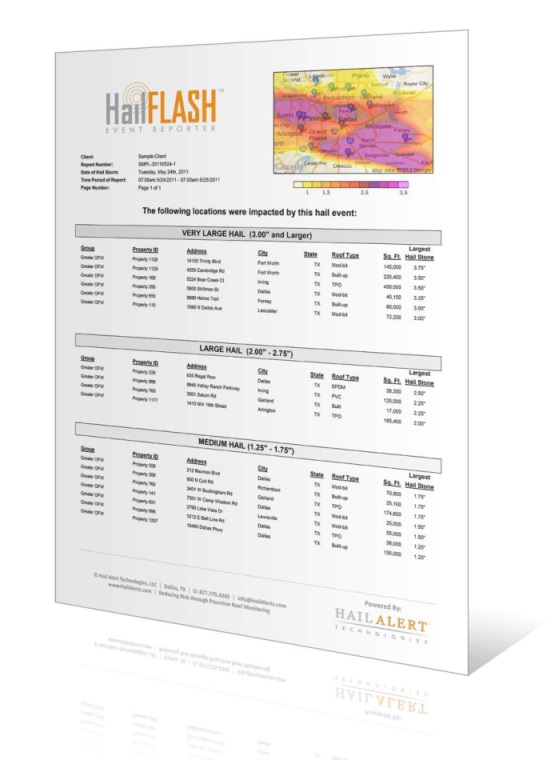A Case Study

Red shows .75″ to 1.75″ hail.
Purple shows 2″ and larger hail
A large nationwide real estate investment trust (REIT) operates a portfolio of 45 commercial buildings in the Charlotte, NC area. To manage these buildings the REIT employs 8 people in their local property management office. This office is centrally located in relation to their 45 Charlotte properties.
On Sunday, March 28, 2010, thunderstorms moved through Charlotte, dropping ¾” to 2” hail across several wide swaths of the city. On Monday the local property managers returned to their office and went about their work unaware that Sunday’s storm had produced any hail.
Hail Alert Technologies was not currently working with the REIT, but several months later, through a relationship with the REIT’s roof consultant, Hail Alert Technologies made the client aware of the past storm and its potential for roof damage.
Inspections of the 22 properties in the path of the hail storm revealed 7 damaged roofs in total; 2 roofs requiring full replacement and 5 others requiring extensive repairs. In all, their insured loss totaled $1,770,000… So how did $1,770,000 in damage go completely unnoticed?
1. Managers were off work
First, the hail storm occurred on a Sunday evening while their property managers were off work and most likely focused on family and personal matters. This is a common occurrence given that 65% of all hailstorms occur outside of the 8-5, Monday-Friday, workweek.
2. No hail damage was reported after the storm
Second, no tenant calls were received reporting damage or leaks at any of the properties. Most tenants and managers incorrectly use interior leaks as the measure of hail damage, but interior leaks can take 3 to 18 months to appear following a storm. This delay occurs because the water that enters through small roofing membrane fractures is first absorbed by the roof insulation. It is not until this insulation is fully saturated that the water then leaks to the interior of the building, but by this point the storm is long forgotten, and the roofs failure is attributed to something other than its true cause.
3. Standard inspections overlook damage
Third, standard annual roof inspections typically focus on roof components that require periodic maintenance, for example flashing laps, sealants, etc, but hail affects different areas of the roof than these. Because hail damage is often concealed from direct view by the naked eye, a specialized inspection focused solely on locating hard to find hail damage is necessary. Without prior knowledge of a damaging hail event, this specialized inspection would not be performed, and the regularly scheduled annual maintenance inspections would most likely overlook the damage.
In hind sight, it is clear how the REIT’s human dependent system overlooked $1,770,000 in damages.
• The hail storm occurred outside of the 8-5 workweek, as 65% of hail storms do, and…
• When the leaks finally began to show, they were not correlated to the unnoticed hail storm that occurred 3 months prior.
Had this REIT been a Hail Alert Technology client at that time of the storm, their managers would have received a Hail Event Report within 24 hours of the storm. With this report, the hail focused inspection could have been scheduled immediately, the connection between the hailstorm and the roof damage instantly recognized, and the accidental oversight of the insured loss avoided. Needless to say, this REIT is now subscribing to our HailFlash® monitoring service.

The ultimate value of HailFlash® is that it pays for itself through the preservation of building owners’ capital funds. In the above case study, the savings from just this one detected hail storm will pay for the HailFlash® monitoring service on the REIT’S 1000+ properties for over 10 years.
Prior to HailFlash®, owners had no option other than to continue the failure prone practice of relying on human observation alone for the recognition of hail damage. Don’t be left in the dark, contact us today to inquire about using the HailFlash® service on all of your properties!